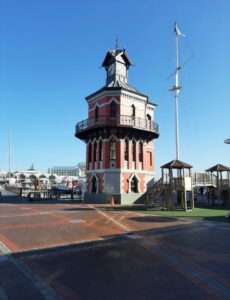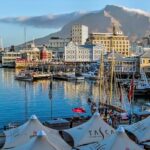Victoria and Alfred Waterfront
The Origins and Growth of the Victoria and Alfred Waterfront
Jan van Riebeeck established a small jetty soon after landing at the Cape, marking the beginnings of Cape Town’s port. Over time, the Cape Town docks expanded as the colony developed. The Victoria and Alfred Waterfront is rooted in this early history.
In June 1858, severe winter storms destroyed over 30 ships in Table Bay, prompting Lloyds of London to stop insuring vessels overwintering in the bay. To address the problem, construction of the breakwater began on September 17, 1860, when HRH Prince Alfred, Queen Victoria’s second son, tipped the first truck of stone. A plaque near the amphitheatre marks the spot. Ten years later, the harbour was officially opened. The area also had electricity a decade before the rest of Cape Town did. The Pumphouse can still be seen today, where the continent’s first electric lights were powered.
Expansion and Historical Legacy
The discovery of gold and diamonds in South Africa necessitated the expansion of the harbour. The Alfred Basin, completed in 1860, was followed by the Victoria Basin to accommodate more ships. The construction of these basins, from 1860 to 1920, left behind a collection of heritage buildings, which still stand today.
The Foreshore and Further Developments
In 1938, a project began to reclaim land between Cape Town’s city centre and the harbour. Although delayed by World War II, the project was completed in 1945, creating the Foreshore area, which enabled the city’s expansion. At this time, the original pier at the docks was demolished.
Decline and Revitalization
By the 1970s, the harbour had deteriorated. However, in the 1980s, the Victoria and Alfred Waterfront redevelopment project was launched, transforming the area into a thriving commercial and cultural hub. The area spans 123 hectares with Table Mountain as the backdrop. Today, Victoria and Alfred Waterfront is South Africa’s most-visited destination, attracting millions of visitors annually. There are 22 important heritage sites, over 450 shops, 101 businesses and 80 restaurants. Plenty of parking is available. You can travel to the waterfront from town or the Atlantic Seaboard on the My Citi bus.
The area is also known for its commitment to sustainability, featuring award-winning green buildings and a black-water treatment plant.
Things to see and do at V&A Waterfront
Some heritage sites and Must-visit places at V&A Waterfront
- The National Maritime Museum tells the story of shipping in Cape Town.
- Dock House is now a hotel, In the 1870s it was the Harbour Master’s residence
- Houses at Portswood Ridge were built in 1870.
- Ulundi Parking Garage was built in 1889 and was previously the home of the Chief Resident Engineer.
- Time Ball Tower was built in 1883 It was used as a repeater station for harbour signals between the observatory and Signal Hill. In 1895 its height was increased from 5.1m to 10.2m. Initially, the ball was hand operated but the mechanism was electrified in 1903. In 1934 the system was replaced by radio signaling.

- NSRI boathouse where the first port lifeboat was housed in 1898
- Harbour café was originally a harbour tea room from 1902.
- Breakwater Prison built in 1902 now accommodates UCT’s Graduate School of Business
- The Old Port Captain’s Building was built in 1904.
- Union Castle Building was built in 1919 for the Union-Castle Mail Steamship Company.
- The V&A Hotel was formerly a warehouse from the 1930s
- Nobel Square includes sculptures of the country’s four Nobel Peace Prize winners, Albert Lutuli, Desmond Tutu, F. W. de Klerk, and Nelson Mandela.
- Chavonne’s Battery was established in the 1800s.
- The Clock Tower is a Victorian clocktower with Gothic characteristics, the windows were, imported from Edinburgh. It was erected as a signal tower in 1883. Originally built as the Port Captain’s office, it never carried a light. On the second floor, a mirrored room allowed the captain an overall view of the harbour. On the ground floor is a tidal gauge mechanism used to check tide levels.

Find some family-friendly things to do at the V and A waterfront
- The Cape Wheel The 40 m high Cape Wheel is one of the most iconic features of the Waterfront in Cape Town, it offers visitors a stunning 360-degree view of the harbour and the city.
- Makers Landing Is a food hub, located alongside the Cape Town Cruise Terminal, with a vision of developing a community in which small food businesses can thrive.
- Operating Hours 10 am – 9 pm (Fri-Sat), 10 am – 6 pm (Sun),
- Two Oceans Aquarium showcases the incredible diversity of marine life in South Africa’s waters. An extension completed in 2013 includes a 1.5-million-litre seawater tank for larger-scale exhibitions at the aquarium.
- The Springbok Experience Rugby Museum offers an immersive look at the history of rugby in South Africa
- Zeitz MOCAA is a contemporary art museum housed in a historical grain silo, showcasing the works of some of the most exciting and innovative artists from Africa.
- Battery Park: 9 am– 6 pm (Mon-Sun),
Victoria and Alfred Waterfront markets
- The Watershed is a vibrant indoor market, showcasing the work of local designers, artists, and artisans. From fashion and jewellery to homeware and crafts.
- Operating hours 10 am – 7 pm (Mon-Sun)
- The Craft Market – The Craft Market is an outdoor market, offering a wide variety of locally made crafts, including textiles, wood carvings, and pottery.
- The Time Out Market opens onto Nobel Square, a public space perfect for picnicking, relaxing and enjoying street performances. There are tables, where you can sit and eat with tourists and locals.
- Oranjezicht City Farm MarketOZCF Market:
- Operating Hours 4 pm – 9 pm (Wed) 8am – 2pm (Sat),8:30 am – 2 pm (Sun)
The Cape Town Diamond Museum is home to a variety of high-end jewellery stores, offering a wide variety of diamonds and other precious stones. Learn about the history of diamonds in South Africa,
Robben Island tours leave from the dock. During the apartheid era, it was a prison for political prisoners. Today, it is a UNESCO World Heritage site.
- V&A Waterfront boat cruises: The Waterfront Duck is a 36-seater amphibious vehicle, find us in front of the Silo Hotel. 073 406 1242
- Waterfront Charters offers budget Half Hour Cruises to Speed Boat Adventures and Sunset Champagne Cruises aboard a yacht 021 418 3168
- Try some of the many Victoria and Alfred Waterfront restaurants
- Helicopter rides from V&A Waterfront
- Let your children take a ride on the Hamleys Express. 021 418 3168
- Check out the Robinson aDry Dock – One of the oldest operating dry docks in the world
#Cape Town tourist attractions V&A Waterfront


